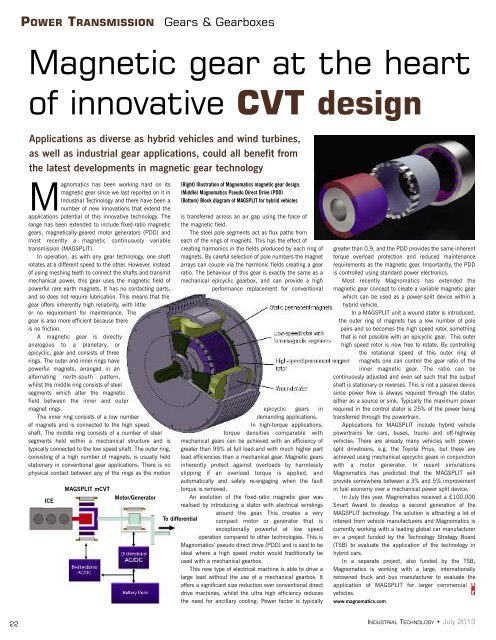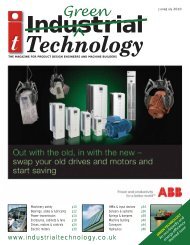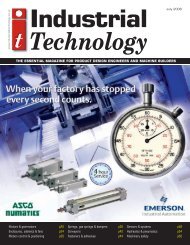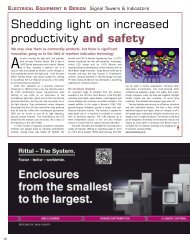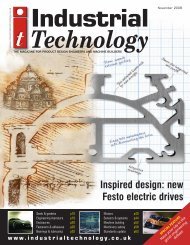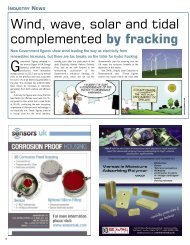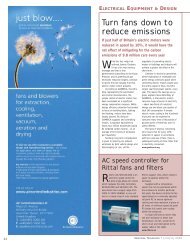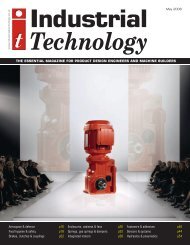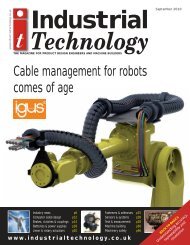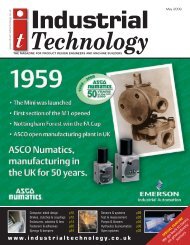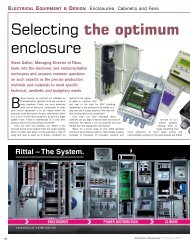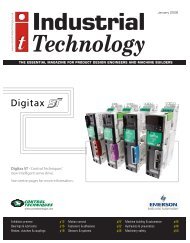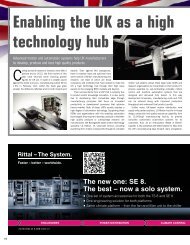machine building & automation - Industrial Technology Magazine
machine building & automation - Industrial Technology Magazine
machine building & automation - Industrial Technology Magazine
Create successful ePaper yourself
Turn your PDF publications into a flip-book with our unique Google optimized e-Paper software.
POWER TRANSMISSION<br />
Gears & Gearboxes<br />
Magnetic gear at the heart<br />
of innovative CVT design<br />
Applications as diverse as hybrid vehicles and wind turbines,<br />
as well as industrial gear applications, could all benefit from<br />
the latest developments in magnetic gear technology<br />
Magnomatics has been working hard on its<br />
magnetic gear since we last reported on it in<br />
<strong>Industrial</strong> <strong>Technology</strong> and there have been a<br />
number of new innovations that extend the<br />
applications potential of this innovative technology. The<br />
range has been extended to include fixed-ratio magnetic<br />
gears, magnetically-geared motor generators (PDD) and<br />
most recently a magnetic continuously variable<br />
transmission (MAGSPLIT).<br />
In operation, as with any gear technology, one shaft<br />
rotates at a different speed to the other. However, instead<br />
of using meshing teeth to connect the shafts and transmit<br />
mechanical power, this gear uses the magnetic field of<br />
powerful rare earth magnets. It has no contacting parts,<br />
and so does not require lubrication. This means that the<br />
gear offers inherently high reliability, with little<br />
or no requirement for maintenance. The<br />
gear is also more efficient because there<br />
is no friction.<br />
A magnetic gear is directly<br />
analogous to a planetary, or<br />
epicyclic, gear and consists of three<br />
rings. The outer and inner rings have<br />
powerful magnets, arranged in an<br />
alternating north-south pattern,<br />
whilst the middle ring consists of steel<br />
segments which alter the magnetic<br />
field between the inner and outer<br />
magnet rings.<br />
The inner ring consists of a low number<br />
of magnets and is connected to the high speed<br />
shaft. The middle ring consists of a number of steel<br />
segments held within a mechanical structure and is<br />
typically connected to the low speed shaft. The outer ring,<br />
consisting of a high number of magnets, is usually held<br />
stationary in conventional gear applications. There is no<br />
physical contact between any of the rings as the motion<br />
ICE<br />
MAGSPLIT mCVT<br />
Motor/Generator<br />
(Right) Illustration of Magnomatics magnetic gear design.<br />
(Middle) Magnomatics Pseudo Direct Drive (PDD)<br />
(Bottom) Block diagram of MAGSPLIT for hybrid vehicles<br />
is transferred across an air gap using the force of<br />
the magnetic field.<br />
The steel pole segments act as flux paths from<br />
each of the rings of magnets. This has the effect of<br />
creating harmonics in the fields produced by each ring of<br />
magnets. By careful selection of pole numbers the magnet<br />
arrays can couple via the harmonic fields creating a gear<br />
ratio. The behaviour of this gear is exactly the same as a<br />
mechanical epicyclic gearbox, and can provide a high<br />
performance replacement for conventional<br />
epicyclic gears in<br />
demanding applications.<br />
In high-torque applications,<br />
torque densities comparable with<br />
mechanical gears can be achieved with an efficiency of<br />
greater than 99% at full load and with much higher part<br />
load efficiencies than a mechanical gear. Magnetic gears<br />
inherently protect against overloads by harmlessly<br />
slipping if an overload torque is applied, and<br />
automatically and safely re-engaging when the fault<br />
torque is removed.<br />
An evolution of the fixed-ratio magnetic gear was<br />
realised by introducing a stator with electrical windings<br />
around the gear. This creates a very<br />
compact motor or generator that is<br />
exceptionally powerful at low speed<br />
operation compared to other technologies. This is<br />
Magnomatics’ pseudo direct drive (PDD) and is said to be<br />
ideal where a high speed motor would traditionally be<br />
used with a mechanical gearbox.<br />
This new type of electrical <strong>machine</strong> is able to drive a<br />
large load without the use of a mechanical gearbox. It<br />
offers a significant size reduction over conventional direct<br />
drive <strong>machine</strong>s, whilst the ultra high efficiency reduces<br />
the need for ancillary cooling. Power factor is typically<br />
To differential<br />
greater than 0.9, and the PDD provides the same inherent<br />
torque overload protection and reduced maintenance<br />
requirements as the magnetic gear. Importantly, the PDD<br />
is controlled using standard power electronics.<br />
Most recently Magnomatics has extended the<br />
magnetic gear concept to create a variable magnetic gear<br />
which can be used as a power-split device within a<br />
hybrid vehicle.<br />
In a MAGSPLIT unit a wound stator is introduced,<br />
the outer ring of magnets has a low number of pole<br />
pairs and so becomes the high speed rotor, something<br />
that is not possible with an epicyclic gear. This outer<br />
high speed rotor is now free to rotate. By controlling<br />
the rotational speed of this outer ring of<br />
magnets one can control the gear ratio of the<br />
inner magnetic gear. The ratio can be<br />
continuously adjusted and even set such that the output<br />
shaft is stationary or reverses. This is not a passive device<br />
since power flow is always required through the stator,<br />
either as a source or sink. Typically the maximum power<br />
required in the control stator is 25% of the power being<br />
transferred through the powertrain.<br />
Applications for MAGSPLIT include hybrid vehicle<br />
powertrains for cars, buses, trucks and off-highway<br />
vehicles. There are already many vehicles with powersplit<br />
drivetrains, e.g. the Toyota Prius, but these are<br />
achieved using mechanical epicyclic gears in conjunction<br />
with a motor generator. In recent simulations<br />
Magnomatics has predicted that the MAGSPLIT will<br />
provide somewhere between a 3% and 5% improvement<br />
in fuel economy over a mechanical power split device.<br />
In July this year, Magnomatics received a £100,000<br />
Smart Award to develop a second generation of the<br />
MAGSPLIT technology. The solution is attracting a lot of<br />
interest from vehicle manufacturers and Magnomatics is<br />
currently working with a leading global car manufacturer<br />
on a project funded by the <strong>Technology</strong> Strategy Board<br />
(TSB) to evaluate the application of the technology in<br />
hybrid cars.<br />
In a separate project, also funded by the TSB,<br />
Magnomatics is working with a large, internationally<br />
renowned truck and bus manufacturer to evaluate the<br />
application of MAGSPLIT for larger commercial<br />
vehicles.<br />
www.magnomatics .com<br />
22<br />
INDUSTRIAL TECHNOLOGY • July 2013


